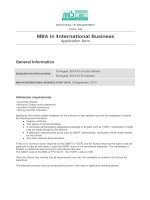Slide international business ch06
Bạn đang xem bản rút gọn của tài liệu. Xem và tải ngay bản đầy đủ của tài liệu tại đây (106.23 KB, 28 trang )
Formulating Strategy
Chapter 6
Prentice
Chapter 6
1
Chapter 6 - Overview
Reasons for going international
Strategic formulation process
Steps in developing international and global
strategies
Prentice
Chapter 6
2
Strategic Planning and Strategy
The process by which a firm’s managers evaluate
the future prospects of the firm and decide on
appropriate strategies to achieve long-term
objectives is called strategic planning.
The basic means by which the company
competes – its choice of business or businesses in
which to operate and the ways in which it
differentiates itself from its competitors – is its
strategy.
Prentice
Chapter 6
3
Reasons for Going International
•
•
•
•
Reactive Reasons
Globalization of competitors
Trade barriers
Regulations and restrictions
Customer demands
Prentice
Chapter 6
4
Reasons for Going International
(contd.)
•
•
•
•
Proactive Reasons
Economies of scale
Growth opportunities
Resource access and cost savings
Incentives
Prentice
Chapter 6
5
The Strategic Management Process
(Exhibit 6-1)
Strategic Planning Process
Define/clarify mission
and objectives
Assess environment for
threats, opportunities
Assess internal strengths
and weaknesses
Consider alternative strategies
using competitive analysis
Choose strategy
Prentice
Chapter 6
6
The Strategic Management Process
Implementation Process
(contd.)
Prentice
Implement strategy through
complementary structure, systems,
and operational processes
Set up control and evaluation
systems to ensure success,
feedback to planning
Chapter 6
7
Steps in Developing International and
Global Strategies
Mission and objectives
Environmental assessment
Internal analysis
Competitive analysis
Global and international strategic alternatives
Approaches to world markets
Global Integrative strategies
Using e-business for global expansion
E-global or e-local
Entry strategy alternatives
Strategic choice
Prentice
Chapter 6
8
Environmental Scanning
It is the process of gathering information and
forecasting relevant trends, competitive actions,
and circumstances that will affect operations in
geographic areas of potential interest.
Prentice
Chapter 6
9
Major Variables Covered in Environmental
Scanning
Political instability
Currency instability
Nationalism
International competition
Prentice
Chapter 6
10
Internal Analysis
Internal analysis determines which areas of the
firm’s operations represent strengths or
weaknesses (currently or potentially) compared
to competitors, so that the firm may use that
information to its strategic advantage
It focuses on the company’s resources and
operations, and global synergies
Prentice
Chapter 6
11
Approaches to World Markets
Globalization is a term that refers to the
establishment of worldwide operations and the
development of standardized products and
marketing.
Regionalization (or multilocal) is where local
markets are linked together within a region,
allowing more local responsiveness and
specialization.
Prentice
Chapter 6
12
Pressures to Globalize
Increasing competitive clout resulting from
regional trading blocs
Declining tariffs, which encourage trading across
borders and open up new markets
The information technology explosion, which
makes the coordination of far-flung operations
easier and also increases the commonality of
consumer tastes.
Prentice
Chapter 6
13
Pressures to Regionalize
Unique consumer preferences resulting from
cultural or national differences
Domestic subsidies
New production technologies that facilitate
product variation for less cost than before.
Prentice
Chapter 6
14
Using E-Business for Global Expansion
“The real story is the profound impact this
medium will have on corporate strategy,
organization and business models. Our research
reveals that the Internet is driving global
marketplace transformation and paradigm shift in
how companies get things done, how they
compete and how they serve their customers.”
www.IBM.com
Prentice
Chapter 6
15
Benefits of B2B
(Exhibit 6-6)
Better relationships with distributors/channels
Improved customer loyalty
Rapid entrance into new geographical markets
Better customer service
Lower operational costs
Expanded sales channel
0
10
Prentice
20
30
40
Chapter 6
50
60
70
16
Global B2B/B2C Strategy
To assess the potential competitive position of the
company, managers must ask themselves the following
questions with respect to B2B/B2C:
• Does the exchange provide a technology solution that
helps industry-trading partners to do business more
efficiently?
• Is the exchange known to be among the top 3-5 within its
vertical industry?
• Does the exchange offer industry-specific technology and
expertise that gives it an advantage over generic
exchange-builders?
Prentice
Chapter 6
17
Conditions Favoring Going E-Global
“The global beachhead strategy makes sense
when trade is global in scope; when the business
does not involve delivering orders; and when the
business model can be hijacked relatively easily
by local competitors.”
M. Sawhney and S. Mandal
Prentice
Chapter 6
18
Conditions Favoring Going E-Local
“[The e-local/regional approach] is preferable
under three conditions: when production and
consumption are regional rather than global in
scope; when customer behavior and market
structures differ across regions but are relatively
similar within a region; and when supply-chain
management is very important to success.”
Sawhney and Mandal
Prentice
Chapter 6
19
Entry Strategy Alternatives
(In order of ascending risk)
Exporting
Licensing
Franchising
Contract manufacturing
Turnkey operations
Management contracts
International joint ventures (IJVs)
Fully owned subsidiaries
Prentice
Chapter 6
20
International Entry Strategies: Advantages
and Critical Success Factors
(Exhibit 6-7)
Advantages
Critical Success Factors
Exporting
Low risk
No long-term assets
Easy market access and exit
Choice of distributor
Transportation costs
Tariffs and quotas
Licensing
No asset ownership risk
Quality and trustworthiness
of licensee
Appropriability of intellectual
property
Host-country royalty limits
Strategy
Fast market access
Avoids regulations and tariffs
Franchising
Little investment or risk
Quality control of franchisee
and franchise operations
Fast market access
Small business expansion
Prentice
Chapter 6
21
International Entry Strategies: Advantages
and Critical Success Factors
(contd.)
Strategy
Advantages
Critical Success Factors
Contract
manufacturing
Limited cost and risk
Reliability and quality of
local contractor
Operational control and
human rights issues
Short-term commitment
Turnkey operations
Revenue from skills and
technology where FDI
restricted
Reliable infrastructure
Sufficient local supplies and labor
Repatriable profits
Reliability of any govt. partner
Management
contracts
Low-risk access to further
strategies
Opportunity gain longer-term
position
Prentice
Chapter 6
22
International Entry Strategies: Advantages
and Critical Success Factors
(contd.)
Strategy
Advantages
Critical Success Factors
Joint ventures
Insider access to markets
Share costs and risk
Leverage partner’s skill base,
technology, local contacts
Strategic fit and complementarity
of partner, markets, products
Ability to protect technology
Competitive advantage
Ability to share control
Cultural adaptability of partners
Wholly owned
subsidiaries
Realize all revenues and
control
Global economies of scale
Strategic coordination
Protect technology and
skill base
Acquisition provides rapid
entry into established
market
Ability to access and control
economic, political and currency
risk
Ability to get local acceptance
Repatriability of profits
Prentice
Chapter 6
23
Factors Affecting Choice of International
Entry Mode
(Exhibit 6-8)
Factor Category
Firm Factors
Prentice
Chapter 6
Examples
International experience
Core competencies
Core capabilities
National culture of home
country
Corporate culture
Firm strategy, goals, and
motivation
24
Factors Affecting Choice of International
Entry Mode
(contd.)
Industry Factors
Location Factors
Prentice
Chapter 6
Industry globalization
Industry growth rate
Technical intensity of industry
Extent of scale and location
economies
Country risk
Cultural distance
Knowledge of local market
Potential of local market
Competition in local market
25









